SUSTAINABLE MANUFACTURING

Influencing how companies think about design, composition and manufacturing to deliver a more positive impact on the planet

CONFINED SPACES
Recognising and planning appropriately for some of the most challenging

EDITION 4 / APRIL 2022 // CONNECT WITH A
BLACKWOODS
TECHNICAL
SAFETY
SPECIALIST // WORKING IN
workplace environments //
FIND OUT MORE ABOUT BLACKWOODS INTERNAL SAFETY PROGRAM ON PG11
CASE STUDY
Following an internal realignment, a council based in the inner west of Sydney recognised the need for an inventory solution to manage inventory for its staff. The benefits have been widespread and included improved productivity, reduced downtime and automated replenishment.

DUST REMOVAL FOR WORKERS
Many workers accumulate dust on their clothing throughout their working day, and it is tempting to use compressed air as a blowdown method for dust removal. Worse still is not removing the dust at all, contaminating offices, cars, and even taking home the particulate from the workplace.


UNSEEN CHALLENGES IN THE WORKPLACE
Confined spaces present numerous physical and environmental hazards to a worker, and are not always obvious. It’s critical that employers understand the risks and ensure the appropriate hazard mitigation techniques are involved to safely complete the task.
PROTECTION FOR THE FRONTLINE
When we picture the uniform of healthcare professionals and frontline workers, we probably imagine them wearing scrubs. What we may not realise, is that besides practicality, there are many other reasons behind the importance of uniforms in healthcare.
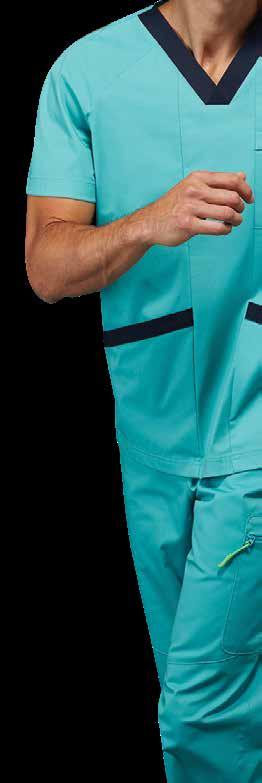
2 Edition 4 / April 2022Safety Spotlight 04 1209
20
ECO
BIODEGRADABLE NITRILE GLOVES


The numbers are astounding: Of the 150 billion gloves that are produced every year, 100 billion of them are thrown away. That is a lot of rubbish, which leads to an environmentally damaging impact that can last for generations.
However, the SHOWA Group, is determined to make a difference and play its part in building an increasingly sustainable present and future. In 2012, SHOWA launched an industry first: biodegradable nitrile gloves. Nowadays, SHOWA continues to build on its foundation by providing the most extensive range of biodegradable hand protection in the market.
Using its revolutionary Eco Best Technology (EBT), SHOWA has designed gloves that decompose in biologically active landfills, as opposed to the 100-year decomposition of regular nitrile gloves.
• EBT is incorporated into the construction of the glove

• Gloves are disposed
• Gloves are transferred and discarded into biologically active landfills
• Microorganisms break down the EBT gloves
• Organic soil, water and bio-gas are produced during the decomposition process
This leads to zero waste. Plus, the bio-gas can potentially be used as a renewable energy source.
“EBT gloves create less of a footprint after-use”, says Brian Moseley, SHOWA RA/QA Technical Manager.
“The beauty once it enters into a landfill, it has a significantly shorter lifespan than traditional nitrile gloves, which is great for the environment. Importantly, it doesn’t lose its critical safety features, whatever industry they’re used in - mining, for food preparation, chemical manufacturing - they get the same level of protection as standard nitrile gloves.
SHOWA was recognised as the first-ever glove company to achieve the Greencircle bio-degradation certificate –an endorsement of the company’s environmental capability.
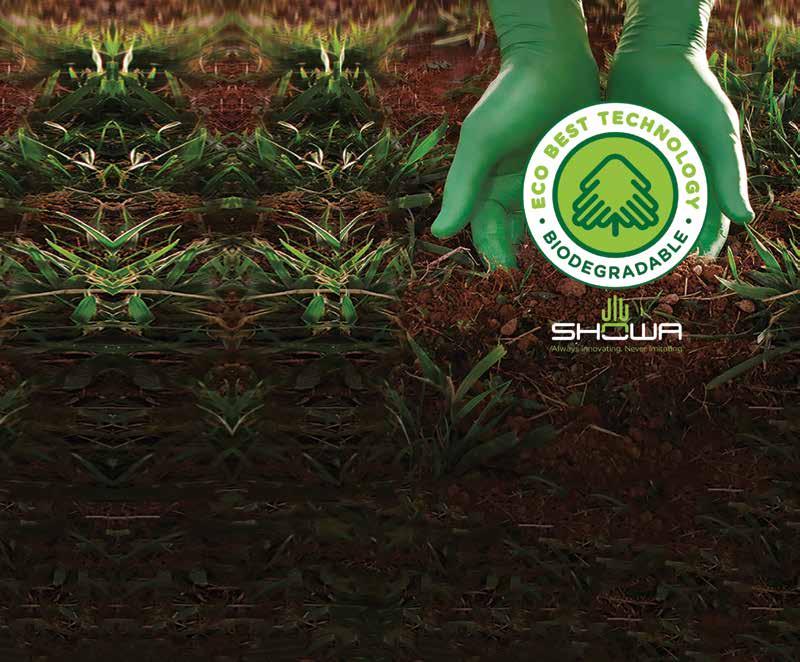
“We chose biodegradation to further reduce our carbon footprint. It also provides our customers a good disposable plan for used gloves - peace of mind knowing the EBT process starts when it enters active landfills.”
SHOWA prides itself in devoting a considerable proportion of its profits to research biodegradable products and the development of fibres that have a reduced impact on the environment. At SHOWA, we always aim to deliver safe and sturdy products that are not just better for us, but better for our world.
and to view the complete EBT range of gloves.

ASSESS | INFORM | EQUIP 3 SCAN FOR MORE INFO.
731 7500PF
BEST TECHNOLOGY
707HVO NSK24
// INVENTORY SOLUTIONS: ON SITE VENDING MACHINES – A SAFE SOLUTION

Many of us could relate to this scenario: We’re out and about and feeling thirsty when suddenly we walk past a vending machine full of drink options, and moments later we’re gratefully downing a water, juice, or flavoured milk. Great!
How convenient. Now, let’s transfer that to the workplace. It’s Saturday afternoon and you need a new part or safety gloves, but the on-site inventory store is shut, and it won’t be open again until Monday morning. So, you must go off-site.
That takes time. And, as we know, time affects productivity or indeed, workers safety.
Blackwoods, which has a diverse range of inventory solutions, is always looking at ways to improve business practices for our customers, and our partnership with the City of Canada Bay is a great example of what can be achieved when we work together.
The City of Canada Bay is a thriving local government area in the inner west of Sydney, Australia’s most populated city. It covers 19.82 square kilometres and has a residential population that is pushing towards 100,000.
In October 2020, after an internal realignment, Canada Bay Council realised it couldn’t have staff in its stores department 24-7, and consequently management sought solutions from its suppliers. As part of its proposal, Blackwoods suggested the placement of an on-site industrial vending machine to manage the council’s critical inventory, most of which was Personal Protective Equipment (PPE).

4 Edition 4 / April 2022Safety Spotlight
“Like most businesses we all had to realign our thinking during the COVID Pandemic. Our first priority is to keep staff safe and to do this we need access to key PPE items 24/7. The vending machine became the most cost effective, space saving and logical solution,” said Marea Getsios, Procurement and Fleet Manager of Canada Bay City Council.
“As well as site approved PPE, the vending machine has given the council a distribution point for Covid related items such as hand sanitiser, antibacterial wipes and disposable respirators. The machine reordering process is automated and through usage reports and stock on-hand reports, we can help the customer avoid stock outs of critical PPE which would impact their work schedules,” said Ben Lawes, Inventory Solutions Specialist of Blackwoods.
SCAN FOR MORE INFO.
Or contact your Technical Safety Specialist
Canada Bay Council became the first council in the Sydney Metropolitan area to adopt this solution, and the benefits have been widespread, including:
• A reduction in consumable spend
• Improved safety and compliance
• Greater visibility of usage among staff and ensuring the approved PPE is being utilising at work sites
• Automated reporting, and managing key product trends
• Access to inventory 24/7 for essential Safety & PPE items
• Higher productivity
• Blackwoods re-stocks machine, ensuring all stock is maintained at high levels
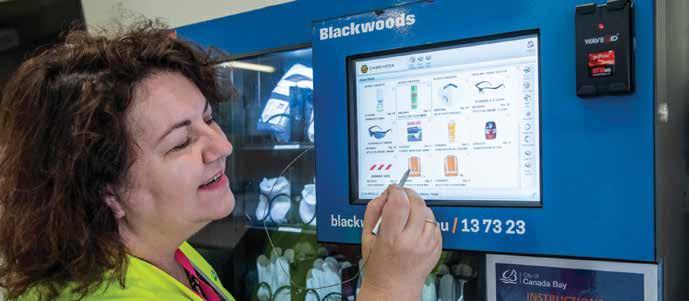
• Touch screen interface with item dispersal in just four seconds
• Less time spent by staff leaving the work site to obtain these goods
Marea went on to say, “At first our staff had a bit of a chuckle and were disappointed it didn’t dispense Soft drink or chocolate bars, but now they are all grateful that Council has prioritised their safety by ensuring key PPE are available around the clock for easy access. There has been a reduction in the hoarding of items such as face masks, sanitisers and gloves.”
The success of the on-site vending solution underlines the versatility and value of Blackwoods. Not only are we an Australian supplier of products, but our technical expertise ensures we find solutions for all our customers. We recognise the critical importance of having efficient access to inventory around the clock, even in the remotest of workplaces. .Blackwoods is motivated by building respectful and understanding relationships that enable us to perform at our best while also continuing to look at ways we can improve our services.
“The City of Canada Bay is really pleased with the service Blackwoods provides and the initiatives of solution such as the vending machine. They make this solution very easy as they fill the [vending] machine and the reporting is automatically generated. We are extremely pleased with how well everything is operating.”
Ben went on to say, “If the site has a need to change items in the [vending] machine in future, we are flexible and make it happen quickly. Quantities on seasonal items such as sunscreen and hydration products can be adjusted throughout the year, to ensure they’re available when needed most, to keep workers safe”.
5ASSESS | INFORM | EQUIP
Marea Getsios Procurement & Fleet Manager City of Canada Bay
// APPAREL MADE USING
RECYCLED PLASTIC BOTTLES

How do we best care for our world, particularly its people, environment and climate? This is one of the most important and pressing issues of our age.
As a socially responsible company, Blackwoods has embedded sustainable business practices and is committed to creating a positive impact for our people, product, community and the environment. “At Blackwoods we are committed to reducing the emissions intensity of our business and improving our resilience to climate change. We are actively working towards achieving zero waste to landfill by 2032 and adopting a more circular economy.”
Australia is the second largest consumer of textiles per capita in the world, with more than 800,000 tonnes of clothing ending up in landfill each year.*
With this in mind, Blackwoods is continually researching and investing in understanding new technologies and global trends in order to deliver a more sustainable apparel product range. One such innovation is to use recycled materials in selected garments.
Using recycled materials gives material waste a new life, while helping to reduce environmental impacts compared to landfilling and incineration of old materials that could otherwise be recycled.**
To ensure responsible use of recycled materials, an internationally recognised standard, The Global Recycles Standard (GRS) has been adopted by Blackwoods. Under these standards, the fabric has been made with at least 20-100% recycled materials, uses environmentally and socially responsible manufacturing processes, and is independently certified within the supply chain.
Other alternates are branded recycled fibre technology innovators that ensure part or all production of the fibre is made in a circular system such as using renewable energy and recycled waste water further reducing emissions and water impact.


As part of Blackwoods’ journey in relation to circularity, we have begun the development of a polyester vest in which the content is made from 100% recycled post-consumer plastic bottles. In collaboration with our customers, we aim to expand our recycled content apparel range to polo shirts and rainwear, ensuring our Hi-Vis WorkWear continues to keep pace with advances in technology and design.
Recycled polyester uses up waste and reduces our need for virgin fibres, and (depending on the recycling technique used) can still have the same quality as a virgin fibre. *** It can be from post-consumer waste or pre-consumer waste, or a mix of both. Postconsumer textile waste is preferred, as under circular design, pre-consumer waste should be minimised.
We are living in fast-changing times, and it’s up to all of us to keep pace with what is happening. When it comes to clothing, if we are all more conscious of the choices we make, we can make a difference.
References can be found here: https://blog.blackwoods.com.au/apparel-made-using-recycled-plastic-bottles
6 Edition 4 / April 2022Safety Spotlight
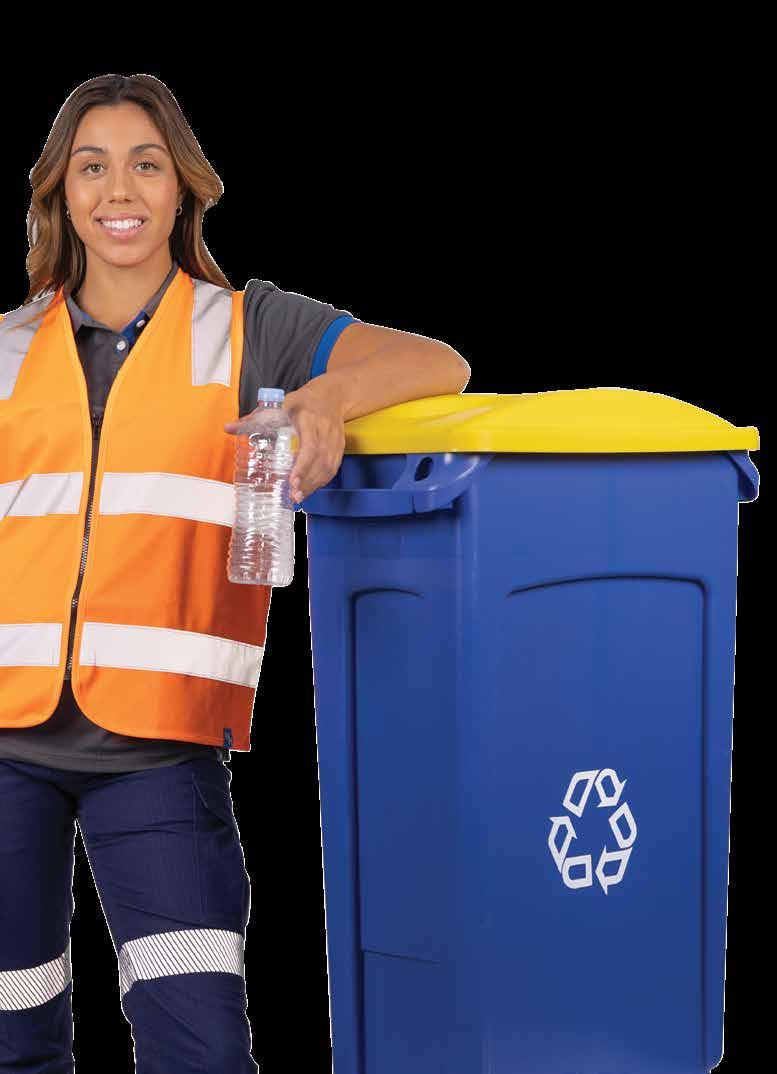

7ASSESS | INFORM | EQUIP
//BIO-BASED VS RECYCLABLE MATERIALS
It can be difficult and confusing, and at times impossible, to negotiate our paths through the language that is used in relation to being environmentally friendly.
Just think about it: biodegradable, compostable, bioplastics, sustainable, carbon footprint, direct emissions - the list is long and exhausting for us to sift through. And then we come to this question: What is the difference between ‘bio-based’ and ‘recyclable’? It’s a question that uvex is doing its best to shed light on for us all.
‘Bio-based’ refers to materials or products that partly come from organic matter, such as corn and sugar cane, as opposed to fossil-fuel based products that derive from coal and oil. Importantly, bio-based plastic products are not recyclable. Recyclable materials are ones that need not be placed in landfill; they can be processed and turned into new products.
SCAN FOR MORE INFO.
To help customers understand the new “uvex protecting planet concept”, uvex has introduced a label system that represents what sustainability measures have gone into producing the product from development and production all the way to packaging and sale.

“The uvex group believes that plant/bio-based materials represent the future. Many products in the uvex glove range also feature the PRODERM institute seal (dermatologically tested) and approved to Oeko-Tex standard 100 meaning the material of the glove is manufactured free of harmful substances,” says Michael Riggall, Director Business Development and Product Manager, Hand Protection, uvex safety Australia and New Zealand.

The labels will be placed on products, such as the uvex phynomic C5, which features 45% bio-based HighPerformance Polyethylene (HPPE). A running stock change will take place as current inventory is sold through, replacing with new inventory that will feature the “protecting planet label” located on the inside of the glove.
“uvex has set itself ambitious goals in terms of the environment, the economy and society”, which form the groups’ sustainability pillars. “In its manufacturing facilities, uvex is working hard to increase energy efficiency and doing everything it can to become carbon-neutral in the near future.”
8 Edition 4 / April 2022Safety Spotlight
Or contact your Technical Safety Specialist
Phynomic C5
AN EFFECTIVE SOLUTION FOR DUSTY WORKERS
We all know the dangers of asbestos and respirable crystalline silica, but there are many other types of dust that can pose challenges in the workplace. Just a few sources of dust include concrete, plastics, rubbers, paper, carpet, soil, stone, grains, and wood. In some way, shape or form dust is present in nearly all our lives. Yet, how many of us take the time to comprehensively clean and de-dust ourselves at the end of each workday? It is something we often take for granted.
If carried out at the end of a worker’s shift or during breaks, a de-dusting using the fully contained JetBlack Safety cleaning booth will reduce dust on people, their clothing, and their Personal Protective Equipment (PPE). This minimises the risk to the workers and their close contacts during breaks and after their shifts. High-volume low-pressure blower-driven air is an effective and economical way of removing dust and fibres. It is also much safer than using compressed air, which unfortunately some workers still use despite the risks of injury.
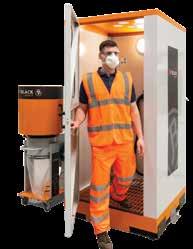
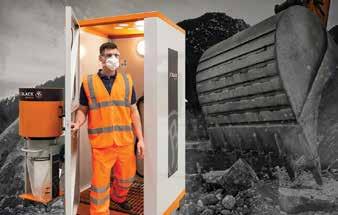
According to Greg Albert, Dynamic Engineering Australia’s CEO, a JetBlack Safety cleaning booth should be a requirement on dusty worksites. “Contaminated workers can continuously enter and exit a booth, moving from dirty zones to clean zones as many times during the day as they need,” he said.
If you are in a dusty workplace, it takes seconds to safely de-dust regularly during your shift. For yours, your colleagues, and your family environment, ‘don’t take the dust with you’. It’s better for all.
Caitlin leads a busy life. Of course, as a mother of two girls aged nine and 12 months, she needs to wear her roller skates! But she is well prepared – she has to be especially as her husband, who’s in the Australian Army is away regularly. That preparedness certainly shows in her work as Technical Safety Specialist, servicing the Brisbane and lower Queensland region.
Having cut one’s teeth with a large industrial welding and gas business early in her career, Caitlin knows a thing or two about working with large industrials. In fact, she was referred to as “Safety Champion” in her role. “It gave me a solid grounding to a successful life in the safety protection space,” says Caitlin. “It provided essential knowledge for my next career move with Protector Al-Safe [prior to Blackwoods], where my experience covered large industrial and mining operations central Queensland, specialising in height safety and respiratory.

Caitlin’s attitude to helping customers is something she takes seriously. “At a conference I attended a few years back, the term ‘Legislation and Standards are built on blood’ was quoted. It really resonated with me on how we should rethink our approach to safety. And so, to avoid reacting and supplying a product as a result of a workplace injury, I see my job crucial to forming solutions for customers in the first instance. I look to thoroughly understand a customers’ work environment, and for the most part use new technologies and our broad network of expertise to our advantage.”
12YRS
SCAN FOR MORE INFO.
contact your Technical Safety Specialist

9ASSESS | INFORM | EQUIP
Or
YOU CAN CONTACT CAITLIN ON CAITLIN DEBIASIO TECHNICAL SAFETY SPECIALIST - QLD +61 408 571 120 Caitlin.DeBiasio@blackwoods.com.au
WORKPLACE SAFETY: MANUAL HANDLING
Fact. Manual handling is the biggest cause of injuries in Australian workplaces. According to Safe Work Australia’s Keep Work, Health and Safety Statistics (2021), body stressing accounts for 37% of serious injury claims in the workplace.
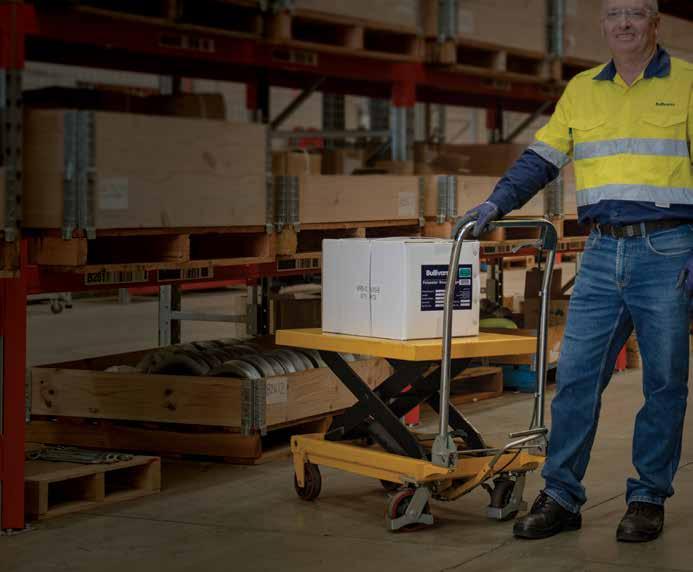
Whether you are lifting, lowering, pushing, pulling, or carrying, the stresses on your body can be immense, especially if you have poor technique or are using the wrong equipment for the task. The list of injuries is long, and includes:
Back, neck, and shoulder injuries
Sprains and strains to other parts of the body
• Hernias
All these injuries fall under the broad category of Musculoskeletal disorders (MSD’s). Unfortunately, some of these MSD’s can sometimes become chronic conditions that can be debilitating and hinder your quality of life. However, injuries need not always occur. As this magazine notes, Blackwoods has implemented S.A.M. (Stop, Assess, Move) in its workplaces. It is a process that entices greater thought before moving an object, and then applying the correct procedures and equipment during the moving.
Rigging and lifting specialist Bullivants, only knows too well the importance of safe manual handling for its employees. “Pacific Scissor Trolleys are great examples of how we can apply techniques like S.A.M. to reduce manual handling injuries. Using hydraulic foot pedals and ergonomic levers, these trolleys are designed to lift and shift loads up to 500 kilograms,” says Mark Laws, Regional Operations Manager, Bullivants.
SCAN FOR MORE INFO. Or contact your Technical Safety Specialist
BODY STRESSING
It is the duty of every employer to make their workplace safe. The Occupational Health and Safety Regulations (2017) of Victoria, have specific duties about identifying and controlling risks of injuries from manual handling; this includes the handling of hazardous materials. If possible, risks should be eliminated, but this is not always reasonably practical; in these situations, employers must consider:

• changing the workplace layout, the workplace environment, or the systems of work
• changing the things used in the hazardous manual handling, such as characteristics of the load or equipment used to handle the load
using mechanical aids
a combination of the above
10 Edition 4 / April 2022Safety Spotlight FAILS, TRIPS & SLIPS 23% 37% Body stressing 28% Falls, trips and Slips of a person 16% Being hit by moving objects 8% Mental Stress 7% Hitting objects with a part of the body 4% Other mechanisms of incident 2% Vehicle collisions 1% Heat, electricity and other environmental factors 1% Chemicals and other substances
37%
•
•
•
•
37% 23% 16% 8% 7% 4% 1% 2% 1%
// AIMING TO REDUCE INJURIES AT WORK
At Blackwoods we are always looking at ways to improve workplace safety, particularly at our distribution centres and trade stores.
Recently we introduced a new program called S.A.M. (Stop, Assess, Move) to help improve the decision-making processes concerning manual tasking. The feedback on S.A.M. has been tremendous. It’s a simple program that incorporates simple steps. How often do we forget the importance of simplicity when working in hectic work environments and WHS compliance?
S.A.M. was successfully launched in the Blackwoods business in October 2021 accompanied by a video highlighting how it can be applied in our workplace. S.A.M. uses the three steps…
After assessing how best to handle these objects, staff then implemented a series of steps as part of S.A.M.’s ‘Move’ process.
• Barbed Wire – source a piece of pipe to slide through the timber coil to enable safe handling. Wrap in cardboard prior to dispatch.
• Rolls of Insertion Rubber – locate the pallet item. Move at the same height and roll off one and onto the other without lifting. Ask a teammate for help.
• 20L Drums – replace old black bunding to prevent the risk of an unbalanced drum falling.
“The S.A.M. program has been strongly supported by the Blackwoods Executive Leadership team and embraced across the business,” says Amanda Haddad, Head of Health, Safety and Wellbeing at Blackwoods.
STOP: How can I get hurt?
ASSESS: What do I need to do to avoid injuring myself or others?
MOVE: Let’s do this safely
For example, at Blackwoods’ Morwell store, staff watched the S.A.M. video, and then visited their warehouse to identify ‘The Uglies’, which were objects deemed difficult to handle.
These included:
• Barbed Wire – coiled, sharp edges, odd shapes.
• Rolls of Insertion Rubber – awkward shapes, heavy, and slippery.
• 20L Drums – large size and falling hazards.
“It challenges our thinking and identifies opportunities to complete a task in a safer way. S.A.M. stories are regularly communicated across the business and discussed in team pre-starts and toolbox talks. It is fast becoming embedded into the Blackwoods safety language and forms part of incident investigations, hazard reporting and shared learnings.
The opportunities for S.A.M. in the future are limitless and we are now working on how we can apply this methodology to other aspects of our business. S.A.M. is not onerous for the business or the team to engage with, it is as simple as an individual assessment of ‘how can I get hurt?’ and ‘what can I do better?’”
So…
STOP. ASSESS. MOVE. Thanks S.A.M.!
SCAN FOR MORE INFO.
Or contact your Technical Safety Specialist
11ASSESS | INFORM | EQUIP
SCAN FOR MORE INFO. Or contact your
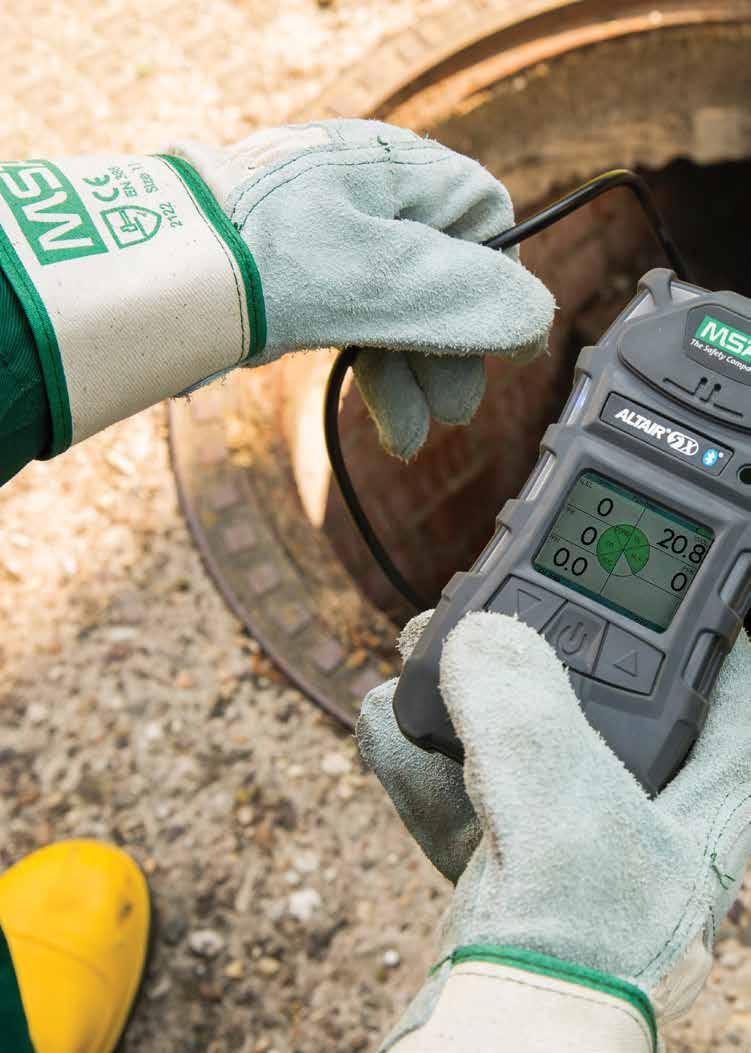
12 Edition 4 / April 2022Safety Spotlight
Technical Safety Specialist
// CONFINED SPACES AND THE UNSEEN CHALLENGES
It is a little-known fact that confined spaces are leading contributors to workplace injuries. A confined space is generally an enclosed, or partially enclosed space that has features which can present potentially dangerous situations. For example, a space that has such conditions as low oxygen levels, unstable materials, contaminants that may cause fire or explosion, or harmful levels of airborne contaminants.
Commonly, people primarily link confined spaces with mining and manufacturing, but there are countless other workplaces of various sizes and locations that are also affected, including:
• Storage tanks and silos
• Pipes
• Manholes
• Elevator shafts
• Ducts
• Culverts
• Tunnels
• Alkylation units
• Trench boxes
• Utility vaults
• Reaction vessels
• Waste treatment facilities
• Maintenance of machines in a confined space

When identifying a confined space, the first step is to see whether the workspace being assessed fits the definition of a ‘Confined Space’ as laid out in the WHS regulations, the Australian Standards, and the Code of Practice. However, “A workspace may not fit the definition laid out in the Standard exactly, but still could be regarded as a hazardous workspace requiring similar controls,” says Ash Mayor, Specialist Trainer and Assessor, 3M Safety and Training.
‘Confined spaces are areas that have been deemed to have met certain criteria: It is an enclosed or partially enclosed space which isn’t primarily designed to be occupied, is at normal atmospheric pressure while people are in it and is, or is likely to be a risk to health and safety due to an unsafe level of oxygen, or contains contaminants including gases, vapours or dusts which may cause fire or explosion, or a harmful concentration of airborne contaminants, or engulfment. 3M Safety and Training.’
Consideration should be given to the number of people in a confined space and work being undertaken and duration of time in the space. “Hazards arising from manual tasks may be exacerbated by physical constraints when working in a confined space. This also can include PPE (Personal Protective Equipment) which can restrict mobility,” says Nick Stinziani, Business Development Manager – Fall Protection, MSA Safety Australia. “Selection and use of approved, fit-forpurpose PPE is of critical importance, and personnel involved in confined space operations must be fully trained in the correct use and maintenance of all related PPE, monitoring and rescue equipment. MSA are able to provide training in this area.”
13ASSESS | INFORM | EQUIP
“We provide nationally accredited training for confined space work including, Enter and Work in Confined Space, Gas Test Atmospheres, Operate Breathing Apparatus Along with practical rescue scenario training to ensure that rescue plans are tested, rehearsed and effective. This may include a trained ‘rescue team’ on stand-by, or the workers being trained and able to conduct an autonomous rescue without relying on emergency services,” says Ash.
When we have confined spaces in our workplaces, we must adhere to appropriate risk assessment processes and follow the definitions provided by Safework Australia’s, Confined Spaces Code of Practice, Regulation 5. Risk assessments come in various forms including JHA (Job Hazard Analysis) or SWMS (Safe Work Method Statement).
“The WHS Regulations require employers to work through the hierarchy of control measures when managing certain risks, such as confined space operations. The hierarchy of control is a system for controlling risks, using a step-by-step approach to eliminate or reduce risks, ranking it from the highest level of protection to the lowest, or least reliable,” says Nick.
Further guidance on the risk management process and the hierarchy of control measures is in the Code of Practice: How to manage work health and safety risks.
Rescue Plans must also be in place. These include:
• Site evaluation
• Identification of proper safety equipment and other required tools, which may include ‘intrinsically safe’ tools and equipment for use in hazardous atmospheres.
• A trained rescue team that knows what procedures to follow should they be required.
• Accredited training that involves practice and hands-on experience for all parties who will work in and around the confined space.
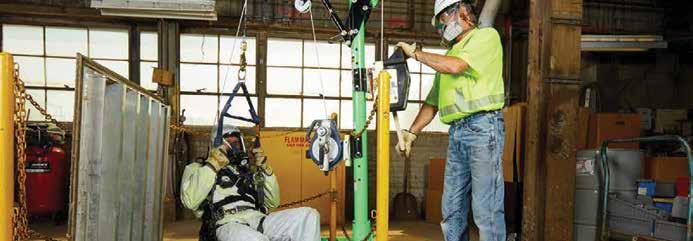
“Workers must be properly trained to work in confined spaces, that at a minimum complies with Regulation 76 of the Code of Practice,” says Ash.
A Rescue Plan must be a dynamic document that can readily adapt to changing situations. Also, employers must understand and acknowledge the relevant National and State Standards, as per Regulation 74 of the Code of Practice. Confined space operations can be hazardous and complicated. There is a lot to consider.
“It is essential the appropriate equipment is used, procedures are followed, and workers are aware of the specific risks, are trained and competent in use of equipment and procedures,” says Darren Gallagher, National Category Manager - Workplace Safety, Blackwoods.
“That said, our Technical Safety Specialists, along with our supply partners MSA Safety and 3M are here to provide customers with right equipment and access to certified training and awareness seminars.”
14 Edition 4 / April 2022Safety Spotlight The purpose of a risk assessment is to: 1. Identify potential hazards 2. Identify the tasks that are required to perform the job 3. Review methods used to complete the tasks 4. Identify the hazards involved and the associated risks related to the method required to complete the task 5. Creation of emergency response procedures 6. Assess the competence of workers to perform the task
DID YOU KNOW.
REGULATION 74: A person conducting a business or undertaking must establish first aid and rescue procedures to be followed in an emergency and ensure those procedures are practised as necessary to ensure that they are efficient and effective. First aid and rescue procedures must be initiated from outside the confined space as soon as practicable in an emergency.
The person conducting a business or undertaking must also ensure that openings for entry and exit are of a sufficient size to allow emergency access; openings are not obstructed; and any plant, equipment and personal protective equipment provided for first aid or emergency rescue are maintained in good working order.
Confined Spaces Code of Practice - Safe Work Australia
REGULATION 76: The training provided to relevant workers must cover:
• the nature of all hazards associated with a confined space
• the need for, and appropriate use of, risk control measures
• the selection, use, fit, testing and storage of any personal protective equipment
• the contents of any relevant confined space entry permit
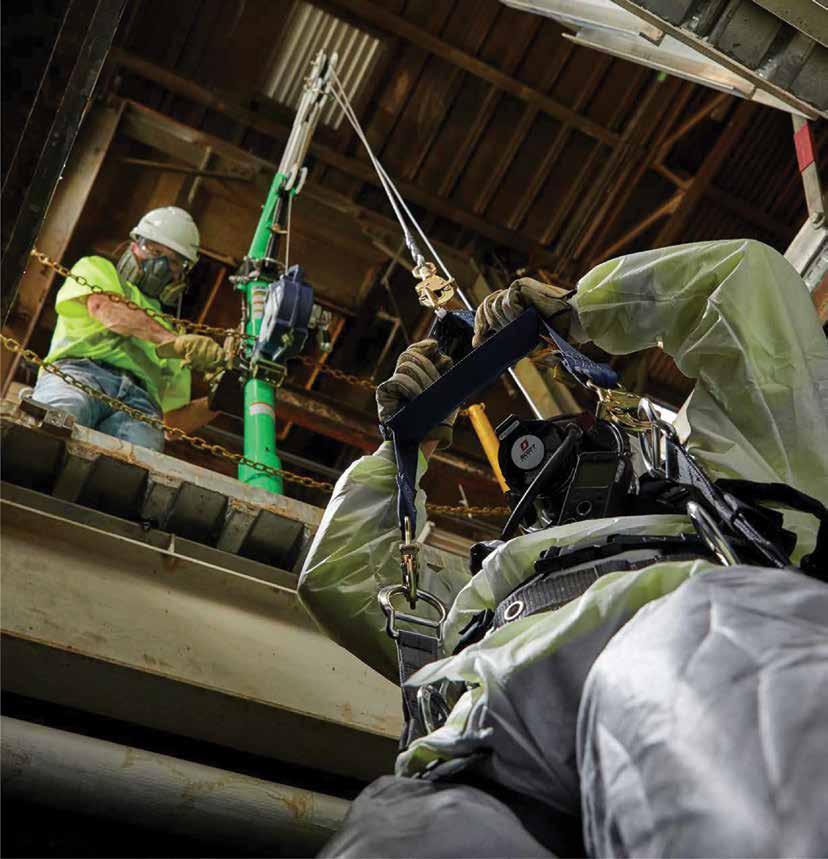
15ASSESS | INFORM | EQUIP
THERE’S NOTHING FISHY ABOUT THIS ECO-FRIENDLY SAFETY EYEWEAR!
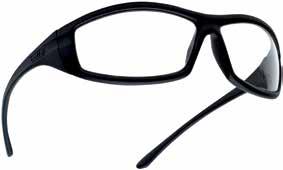
Bollé Safety has had a long-standing commitment to providing eyewear that looks good and leads the market in performance and protection. In recent times, they’ve re-shaped that commitment to include environmental sustainability.
In 2014 Bollé Safety released the SOLIS B-Green, the first ever EN166 Standard-compliant eyewear with an eco-frame. Then in 2019 Bollé launched its highly successful SOLIS Go Green, eco-friendly safety eyewear made from nylon that is sourced from recycled fishing nets. That’s right, nylon fish nets.
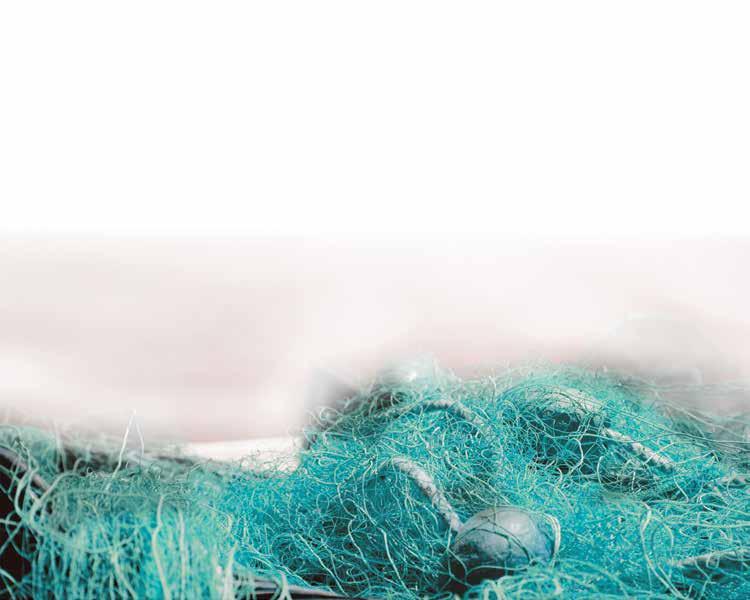
“It’s about minimising our carbon footprint - striving to not only reduce and recycle, but also exploring and adopting more ecofriendly materials,” says Rimma Shabanova of Bollé Safety.
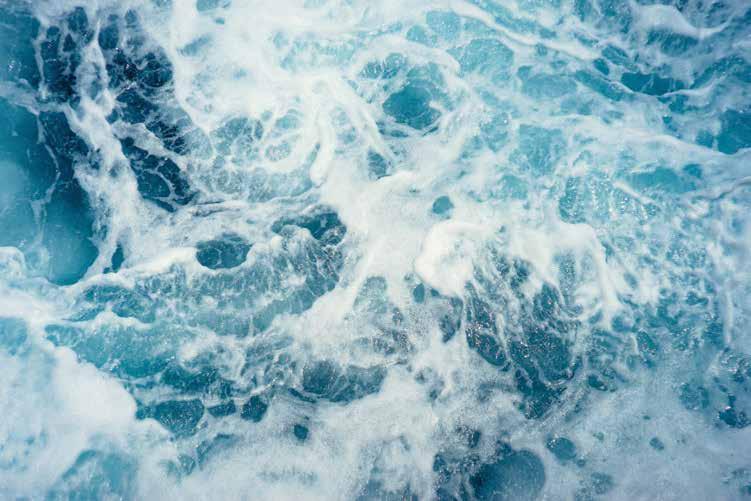
“Solis Go Green works on two fronts. Firstly, we’ve used a new frame material – that is a nylon frame made of recycled fishing nets with a nice velvety finish. It’s a full frame design, yet it’s a very lightweight model. And secondly, the packaging. It’s important for us to find ways to improve the packaging and reduce the amount of packaging used overall. That is why Solis Go Green is only available with our eco-packaging offer that is a 100% recycled & recyclable cardboard and paper. These changes mean zero plastic and 30% less waste.”
Its features include:
• Fully recyclable (including packaging)
• 100% compliant with international safety standards (including AS/NZS 1337.1 for Medium Impact Protection)
• Wrap around frame
• Non-slip temples
• Anti-scratch/Anti-fog coating
• Smoke or clear lenses.
Determined to be the best in the market for sustainability, Bollé Safety adheres to its Go Green initiative that focuses on three core areas:
• Environment: optimising product design, manufacturing processes, sourcing and supply to reduce waste carbon footprint.
• Social: Customers have the right to trust the companies they buy from. Bollé Safety believes in making high-quality products that offer maximum protection in an ethical way.
• Governance: Transparency and board ethics are of paramount importance for the ethical and sustainable longevity of a company. Bollé Safety practices employment equality, regardless of gender, race, ethnicity, or religion.
Above all, Bollé Safety recognises the importance of working together. They’re part of a global community and committed to help each other make a better world for all of us.
SCAN FOR MORE INFO. Or contact your Technical Safety Specialist

16 Edition 4 / April 2022Safety Spotlight
0282 8736
// PREVENTING ELECTROSTATIC DISCHARGE BY CHOOSING THE RIGHT FOOTWEAR
Electrostatic Discharges (ESD) are more commonly known as ‘static electricity’. This involves the sudden flow of electricity between two electrically charged points, including humans, and can be caused by contact, electrical shorts, or dielectric breakdowns. ESD is very common but can be much more damaging than the old school prank of rubbing your shoes on the library carpet and then zapping your mate by touching his ear with your finger.
In some work environments, special efforts are made to have ESD-secured areas to protect electrical components and equipment, including integrated circuits, that can be permanently damaged by large and small voltages; at times these discharges can be so little that humans, who are highly conductive, can’t even feel them.
The effect of ESD cannot be overlooked: ESD can cause explosions in gas, fuel vapour, and coal dust. ESD can be incredibly dangerous.
The Oliver ST40 Series of footwear provides ESD protection to wearers, thus protecting equipment and helping the prevention of igniting flammable materials. When considering purchasing ESD footwear it is critically important to understand the difference between ‘Anti-Static’ and ESD protection. To meet relevant standards and specifications, ‘Anti-Static’ footwear must have electrical resistance between 0.1 and 1000 Mega Ohm (MΩ), while ESD protective footwear must resist between 0.1 and 100 Mega Ohm (MΩ).
“There are a lot of misconceptions when it comes to ESD and Antistatic Footwear. Both dissipate static charge, but only ESD rated footwear can guarantee that uncontrolled electrostatic discharge won’t occur. This is because the shoes restrict the flow of electricity in a safe and controlled manner by preventing the build-up of electrical charge in the body in the first place,” says Brett Huggins, Product Development Manager of Honeywell Industrial Safety.
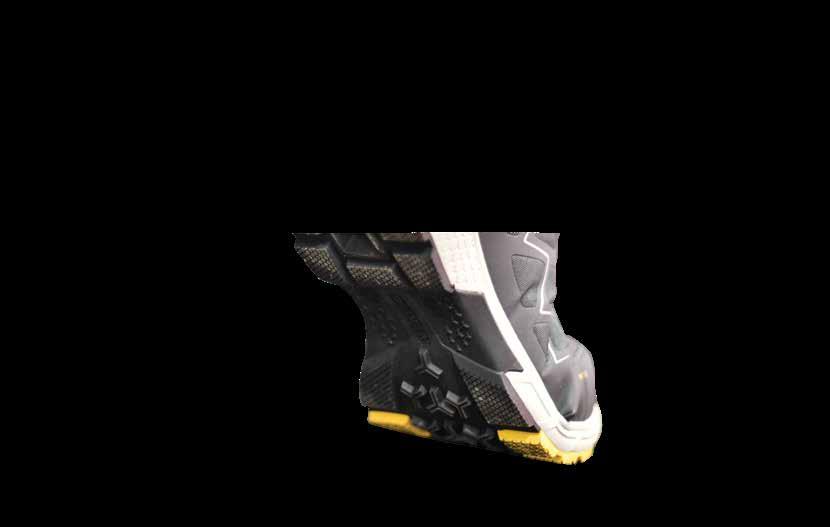
There is only a small range of ESD shoes available in Australia, yet the diversity of workers that they cater for is extensive. Occupations and industries that may need such footwear include engineers, electricians, IT workers, semiconductor and electronic industries, plastic/polymer processing, painting and coating, biotechnology, pharma, oil and gas, automotive, and all other industries that use easily combustible substances.
SCAN FOR MORE INFO.
Or contact your
Safety Specialist
17ASSESS | INFORM | EQUIP
Technical
40-810
COCCIA
Janelle Coccia knows all about trust and respect. She is the mother of two daughters, aged 12 and 14, and that position comes with a multitude of caps to wear: one for listening, another for being a confidante, and there’s also advisor, rule-setter, sympathiser, empathiser, taxi driver… the cap-rack is large!
“As a mother, for me it’s important to keep the lines of communication open - the good, the bad, the ugly - to gain trust,” says Janelle. “I see them being able to approach me without judgement; I feel this an important value with my working relationship, particularly customers.”
Janelle has worked at Blackwoods for 25 years, most of her working life. Most of her roles have concerned safety, and it’s in this capacity that Janelle provides a wealth of experience to both Blackwoods and customers.
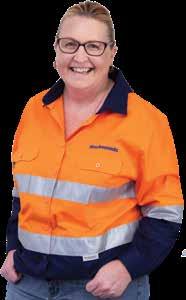
“It’s the old adage - Everybody deserves to go home in the same condition as they arrived, so that’s kept me enthusiastic about what I do.”
Janelle thrives on finding solutions for the customer, particularly in relation to technical components. Being specific to every situation is the key. Currently, Janelle has been examining solutions for metal work apparel at a customer site. Workers have occasionally suffered burns, and Janelle is looking at ways to prevent these injuries from happening; this has included discussions with an apparel manufacturer about re-designing the collars of the neck to furnace coats.
Janelle has a great rapport with customers who agree that ‘she gets the job done.’ It’s understated praise for a person who knows all about trust and respect.
BENEFITS OF ANTIFATIGUE MATTING AND RISKS AROUND PROLONGED STANDING
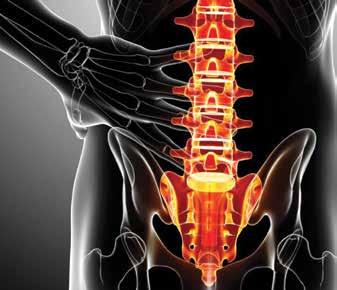
How many of us know the feeling? We arrive home after a full day’s work and we say as we walk through the door: ‘Geez, I can’t wait to get off my feet!’
There is already much attention paid to workers who sit down for long periods, but we must also recognise the hardships of standing at work for extended periods in such jobs as retail customer service, warehouse and industrial work. Problems that can occur include lower back, shoulder and neck pain, poor circulation, clotting, swelling in the legs, varicose veins and cramping.
The use of Safety and Anti-fatigue matting is encouraged in many workplaces. Studies have shown such matting can reduce worker tiredness and discomfort by 50% in comparison to working on hard floors.*
The mats’ features include:
• Cushioning effects that stimulate continuous micro movements, thus reducing blood pooling in the legs.
• Ergonomic design that corrects balancing of the body.
Companies that have installed appropriate Safety and AntiFatigue matting have reported reductions in injury-related absenteeism of workers, and fewer medical claims.
25YRS SCAN FOR MORE INFO.
Or contact your Technical Safety Specialist
18 Edition 4 / April 2022Safety Spotlight
YOU CAN CONTACT JANNELLE ON JANELLE
TECHNICAL SAFETY SPECIALIST - STH NSW +61 459 805 179 Janelle.Coccia@blackwoods.com.au
*Studies by Professor Redha Taiar, Biometrics Engineer at University of Reims, France
// WORKPLACE SAFETY: PPE HAND PROTECTION

‘When the gloves are off’ is a popular saying that means the fight is well and truly on. However, if we use that expression in the workplace, it can have a very different meaning.
When the gloves are off in the workplace all too many injuries occur. Forget all the excuses‘gloves get in the way of a good grip’, ‘I can do a better job without gloves’, ‘gloves make my hands sweaty and slippery’ - the simple fact is, when the gloves are on, less injuries occur.
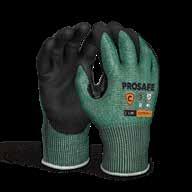
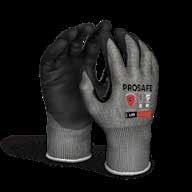
“Prosafe Durashield range of gloves is uniquely positioned to provide different types of protection that is comfortable to wear, all the while reducing the need for glove removal. It is also the first back of hand ‘Impact Protection’ glove added to the Prosafe range.”
“Injuries that are prevented or protected against when wearing the correct glove include, cuts and lacerations caused by sharp materials and objects, back of hand impact ‘struckby’ injuries from hammers, falling masonry and timber, and crushing or pinching injuries from machinery and equipment used in confined spaces,” says Nic Williams, Blackwoods Own Brand & Product Development Manager.
Designed with the aid of the latest technology, Prosafe’s new Durashield range of gloves provide a solution for workers who take the gloves-off approach to their jobs, even when they know the risks they are taking. Of course, all glove designers are continually looking at ways to produce products that offer stronger protection and higher cut resistance, but there is another feature that cannot be overlooked. In fact, this feature is the one that frequently determines if a worker will wear gloves. It is comfort. A glove that workers find comfortable is a glove they will wear consistently.
Prosafe Durashield Gloves have state-of-theart linings and coatings that ensure comfort, protection, and dexterity; you can even use touchscreens and smart phones without taking your gloves off.
“The complete Prosafe Durashield glove range has also been extensively tested and shown to have an increased resistance to abrasions. It exceeds the highest performance level requirement, level 4, which helps increase the useful lifespan of the glove and reducing the need for early replacements.”
SCAN FOR MORE INFO.
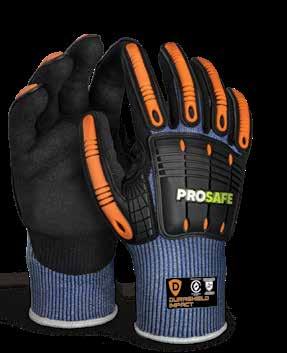
19ASSESS | INFORM | EQUIP
Or contact your
Blackwoods Specialist
Cut B
Cut
F
Cut D
Cut
C
HYGIENE & PROTECTION FOR THE FRONTLINE
are at the
Day in, day out. The risks to personal health and safety can be dangerously high. Our nurses and health care professionals can be exposed to a vast array of transmissible illnesses and infections. As we have seen so dramatically during the Covid Pandemic, the use of the highest quality clothing and protective equipment is essential for all our frontline heroes.
NNT Uniforms, Australia’s leading corporate and healthcare uniform apparel brand, includes the Next Gen Active Scrubs in its new 2021-22 range. The scrubs are made from specifically designed high-quality fabrics, many of which contain anti-microbial properties that inhibit the spread of bacteria and germs. Select garments also include Polygiene, an antibacterial finish that combats a wide range of odour-causing bacteria, this allows
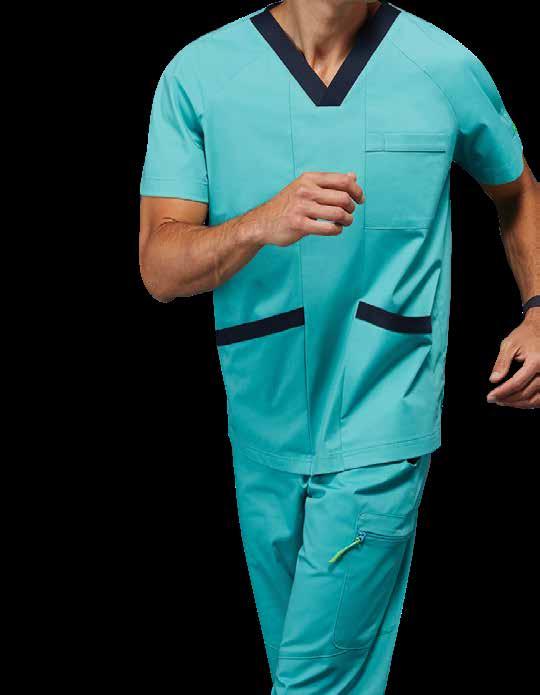
the wearer to feel fresher for longer, which can be very important in highly active roles. This factor also assists with the longevity of the garment; thus, a Polygiene-treated product can significantly reduce the environmental impact, in comparison to garments that aren’t treated; this is an important consideration because health workers’ uniforms are prone to heavy use, which incorporate long shifts then daily washing and ironing cycles.
“When we consider the environment our health workers work in, more so than ever, scrubs need to support, not hinder their performance. NNT’s Next-Gen Active Scrubs are the core uniform for frontline workers, designed based on feedback from real frontline workers, these yogainspired scrubs are jam-packed with features including stretch for comfort and movement, cotton blend for breathability, loads of pockets to keep their tools safe and our newest fabric innovation,” says Elizabeth Cirocco, NNT Product and Brand Manager, Workwear Group.
The use of high performing scrubs is integral to looking after our health workers. From hospitals to laboratories, the use of scrubs gives each worker a greater sense of security and confidence.
“Our team wanted to create a new range of scrubs that offered a more
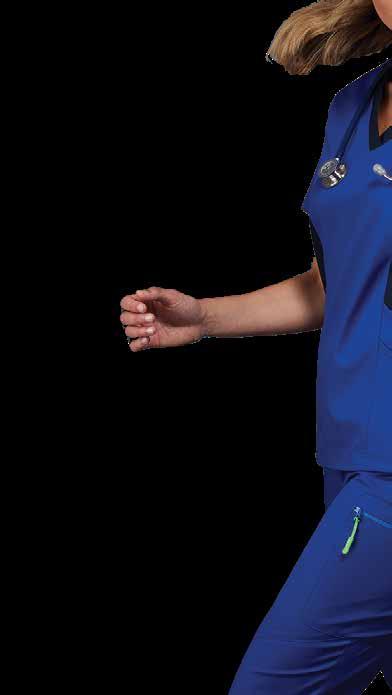
20 Edition 4 / April 2022Safety Spotlight
We know our health workers
frontline.
durable fabric alongside our wider range of scrubs. Using Polygiene technology NNT’s vital range of scrubs have been treated to inhibit the growth of odourcausing bacteria in the fabric, meaning frontline workers will stay calm (and fresh) under pressure.”
Created by an in-house design team that has used information obtained from extensive trials and feedback, the NNT Next Gen Active Scrubs have antibacterial and anti-microbial features, as well as new and improved fabric with increased durability and colourfastness. Specific design features include an abundance of pockets; every healthcare worker knows the need for space and access during the long workdays of being on the move. Importantly, the position of every pocket has been extensively wearer-tested. A feature of NNT is the fact that they listen



to, and seek advice from those at the healthcare frontline, to ensure we keep pace with workplace changes and the demands of the workers.
“NNT has included wearer trials with their consumers since we launched in 1962 – this allows us to stay close to the customer and gain valuable insights on their needs. Our wearer trials provide robust data to test how the product performs in the environment it is designed for, allowing our design, product and development team to hear feedback directly from the wearer on their needs and expectations.”
INFO.
The Next Gen Active Scrub Range is playing a lead role in supporting our frontline health workers. We help:
• Create a sterile healthcare environment
• Protect health professionals
• Easy identification of health professionals
• Provide modern apparel that is practical, comfortable, flexible, and easy to wash.
• Furthermore, the clothing is budget-friendly!
At this precarious time in world history, we are proud of the role we are playing in supporting those on the frontline. We need you. And we will forever thank you.
21ASSESS | INFORM | EQUIP
Technical Safety Specialist
// LEGAL REQUIREMENTS
FOR PROTECTIVE GLOVES IN AUSTRALIA
Safety standards are designed to protect us. In the workplace they assist us in the provision and maintenance of safety levels and the products we use. The International Organization for Standardization (ISO) and Australian/New Zealand Standards (AS/NZS) help classify specific product attributes and communicate the quality and protection levels of personal protection equipment (PPE).
European Standard EN388 2016 is the benchmark for protective gloves and has been wholly adopted in Australia and New Zealand by AS/NZS 2161.3 2020.
Protective gloves should be labelled with the relevant symbol that reflects the international standards that the gloves comply with. Manufacturers are not required to label gloves with the marks licensed by independent certifying organisations, in order to demonstrate that the gloves comply with the Australian standard.
uvex gloves sold in Australia comply with standards that are equivalent to the Australian standard. Gloves have been laboratory tested under certified conditions and are applicable with relevant standards, including ISO 21420:2020 and EN 388:2016 A1:2008.

SCAN FOR MORE INFORMATION.
To understand more about uvex’s commitment to quality and meeting ‘Legal Requirements for Protective Gloves in Australia’
22 Edition 4 / April 2022Safety Spotlight
DESIGNING A LOTO SYSTEM
Don’t be mistaken. LOTO is not something you buy a ticket for at the local newsagency. It is a safety procedure (Lockout Tagout: LOTO) that is used to ensure dangerous machines and energy sources are properly shut off or isolated, and are not able to be re-started until any required maintenance or repair work is completed.
As we know, technology is pushing the world along quickly, and this pace of change should influence how we think about LOTO in our workplaces. Although many companies are prepared for the ‘now’ and have suitable safety devices and padlocks, fewer companies have considered the future. For example, when your company has more machinery in another two years, will you have the same safety system in place? And will you still be using a paper-based permitto-work system? Put simply, the future is now and it is time to begin futureproofing your systems.
Electronic Permit To Work (ePTW) is becoming increasingly popular on Australian worksites. ePTW enables high quality permits that comply with company procedures. It also provides effective delegation of responsibility, notifications of deviations or exceptions, high visibility of work in progress through up-to-date communication, and a complete and comprehensive audit trail. This leads to improved efficiencies and no more paper shuffling.
RFID tags can work hand-in-hand with ePTW. Using decodable radio signals, RFID tags can be allocated to individual isolation points in an ePTW system or database, enabling improved accuracy of isolation points, and conformity to procedures.
So, here’s the question you need to ask: ‘Is my company prepared for the future by preparing for the ‘now?’ Efficient, error-proof electronic systems are the way of the world.
“LOTO is an investment in your worker’s safety and your site’s ability to run effectively. It’s important to have the correct equipment available on your site, and true cost savings can quickly be achieved through efficiencies in time and accuracy with a well-planned, scalable, future-proofed ePTW system. Our Safesite Program can assist in achieving Industry Leading practice,” says Paul McGregor, National Key Account Manager – Safety & Industrial, Mayo Hardware.
SCAN FOR MORE INFO.
Or contact your Technical Safety Specialist
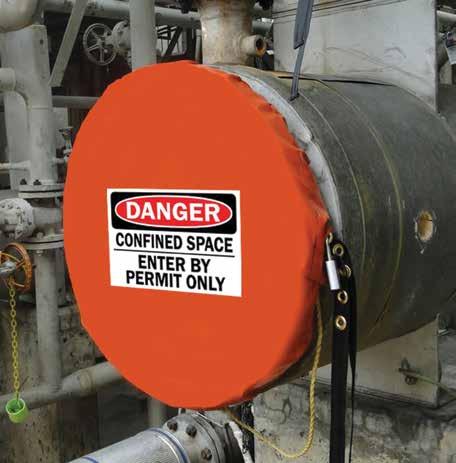
23ASSESS | INFORM | EQUIP
If you are considering a review or update of your LOTO programme, Blackwoods and Mayo Hardware have all the relevant information, including case studies of companies that have implemented new and improved methods.
A SUSTAINABLE FUTURE WITHOUT SAFETY BEING COMPROMISED
We keep hearing about ‘the future’, and how we, as a global society, must change our ways for the welfare of the world. However, the clock is ticking, and the future needs to be the now.
Ansell is dedicating much time and resources to developing and enhancing sustainable practices across its manufacturing processes. Reducing emissions, reducing carbon footprints, and decreasing landfills are of paramount importance to a company that is determined to lead the way.
Ansell’s glove products are just one example of the new age. Many gloves in the industry are made from materials that have significant impact on the environment, such as petroleumderived products, cotton, and rubber. As a result of a series of innovative partnerships Ansell is now using materials such as recycled yarn that is made from plastic waste.
“For example, as a start, we are replacing the polyester yarn in the over-edging of our gloves with a recycled yarn made from plastic waste in styles such as the HyFlex 11-561,” says Theo Oostveen, Product Portfolio Manager of Ansell Ltd.
Critically, the safety value of the new-age products is not being compromised. “Before any product becomes a part of the Ansell range, it undergoes rigorous testing. This testing not only includes the requirements of standards and norms, as per the various global regulatory bodies we adhere to, but also in-field testing by those who rely on the products every day.”
The market feedback obtained during the trial and testing process is pivotal to ensuring that the product not only complies with standards of safety, but also ensures the user of the performance they required to effectively and efficiently complete their tasks.”
“Furthermore, we have a structured and ethical approach to sourcing raw materials as part of our Supplier Management Framework.”
Ansell has also committed to minimising package use by 2026. This will include:
• Removal of zero use packaging components
• Leading the market to digital
• Reduction of packaging material utilisation
• Sustainability driven packaging configurations
• Shipping volume minimisation
End of life programs are also being implemented, including:
• Fully recyclable and right material choices
• Innovative circular solutions
• Zero waste to landfill commitment
• Leadership and advocacy to inspire the entire manufacturing industry
With the constant changes in safety requirements and a need to look after our planet, Ansell is committed to a sustainable future, all the while ensuring premium product quality and safety performance remains.
Key focus areas for Ansell from the United Nations Sustainable Development Goals (SDGs), aimed at addressing many of the world’s most pressing challenges
Some of Ansell’s raw material and associated manufacturing processes are water intensive.
Ansell has a role to play in enegry efficency and renewables.
Ansell supports the Paris Agreeement and is responding to the global threat of climate change.
Product stewardship is a recent focus area for Ansell
Ansell’s business is closely tied to healthcare As a global emplyer, Ansell can help to address inequality.
24 Edition 4 / April 2022Safety Spotlight
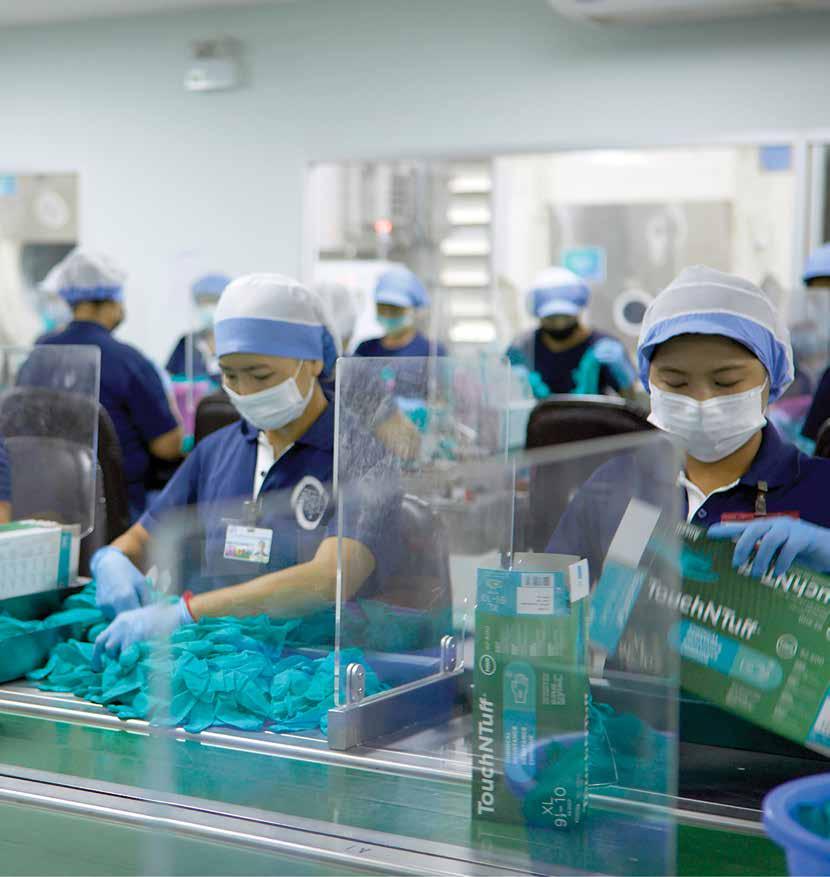

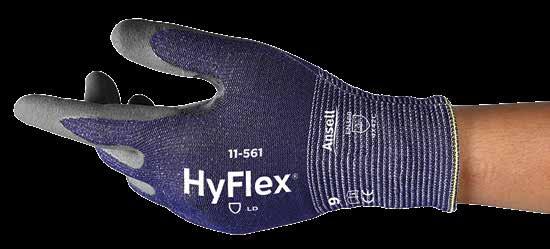
25ASSESS | INFORM | EQUIP Hyflex® 11-561 SCAN FOR MORE INFORMATION. Or contact your Technical Safety Specialist Glove over-edging
OUR TECHNICAL SAFETY SPECIALISTS
Our team of Technical Safety Specialists are experienced in a wide range of industries and invest time with customers to understand the specific hazards they face.
They share knowledge so that customers are equipped to ensure that every employee, contractor and visitor returns home healthy and injury free.
The Blackwoods technical safety team help customers get the right product, technical knowledge and training, at the right time.
Together we help more people build a better Australia.
MICHAEL SIMPER
TECHNICAL SAFETY SPECIALIST - STH WA

+61 429 347 245
Michael Simper@blackwoods.com.au
JON MARTIN
TECHNICAL SAFETY SPECIALIST - WA
Jon.Martin@blackwoods.com.au
CRAIG POSTILL
TECHNICAL SAFETY SPECIALIST - SA/NT 16YRS
+61 417 998 488
Craig.Postill@blackwoods.com.au
DREW DAUNCEY
TECHNICAL SAFETY SPECIALIST - VIC/TAS
+61 408 624 653
Drew.Dauncey@blackwoods.com.au
CHRIS BEATON
TECHNICAL SAFETY SPECIALIST - VIC
+61 437 998 112
Chris.Beaton@blackwoods.com.au
PETER AGNOS
HEAD OF TECHNICAL - NATIONAL +61 417 819 584
Peter.Agnos@blackwoods.com.au
DEAN ANDERSON
TECHNICAL SAFETY SPECIALIST - QLD
+61 407 728 860
Dean.Anderson@blackwoods.com.au
SIMON FOSTER
TECHNICAL SAFETY SPECIALIST - QLD +61 418 259 239
Simon.Foster@blackwoods.com.au
CAITLIN DE BIASIO
TECHNICAL SAFETY SPECIALIST - QLD
+61 408 571 120
Caitlin.DeBiasio@blackwoods.com.au
BRENDAN RYAN
TECHNICAL SAFETY SPECIALIST - NTH NSW
+61 417 231 550
Brendan.Ryan@blackwoods.com.au
LESTER DAVIES
TECHNICAL SAFETY SPECIALIST - NSW METRO
+61 418 265 269
Lester.Davies@blackwoods.com.au
JANELLE COCCIA
TECHNICAL SAFETY SPECIALIST - STH NSW
459 805
Janelle.Coccia@blackwoods.com.au
KAREN MCNAMARA
DEVELOPMENT MANAGER
& FOOTWEAR -
407
Karen.McNamara@blackwoods.com.au
DARREN GALLAGHER
SHANE WOOD
LEIGH EAM
26 Edition 4 / April 2022Safety Spotlight // MEET
8YRS
6YRS
23YRS
12YRS
13YRS
12YRS
34YRS
30YRS +61
179
25YRS +61
934 112
BUSINESS
APPAREL
NSW 19YRS +61 438 439 155
24YRS +61 439 021 868 Darren.Gallagher@blackwoods.com.au
NATIONAL CATEGORY & SOURCING MANAGER , WORKPLACE SAFETY, RESPIRATORY,FALL PROTECTION, AND LIFTING & RIGGING +61 418 417 779 Shane.Wood@blackwoods.com.au
NATIONAL CATEGORY AND SOURCING MANAGER EYE, FACE, HEAD, HEARING & HAND PROTECTION +61 457 859 360 Leigh.Eam@blackwoods.com.au
NATIONAL CATEGORY AND SOURCING MANAGER APPAREL AND FOOTWEAR
// OUR INTEGRATED APPROACH TO SAFETY
For over 140 years, we’ve been Australia’s leading industrial and safety equipment provider. You’ll find us across the country on construction sites, mine sites, and on desert roads, making sure workers are protected when it matters most.
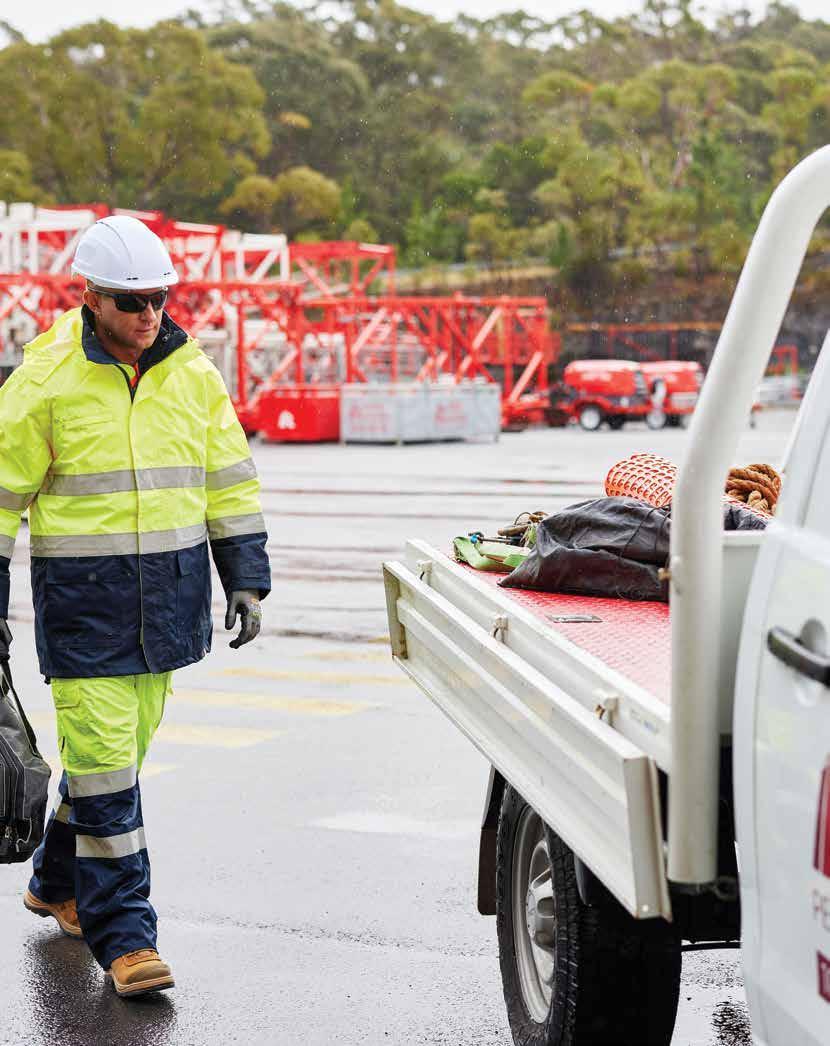
We work with customers to understand the specific hazards they face. Drawing on the knowledge of our technical team, we share the expertise needed to review, test and manage safe work practices.
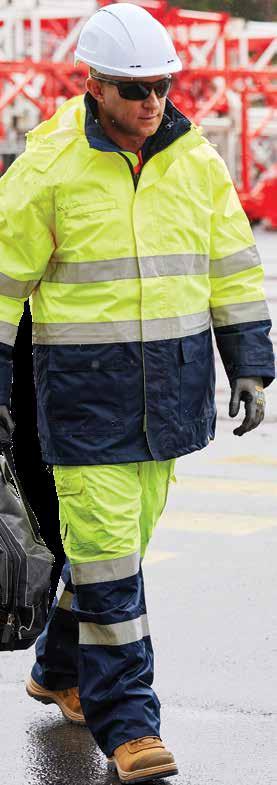
Where stock is critical and time is limited, we can provide streamlined solutions using smart technology to help you better manage inventory, reduce cost, free-up capital and improve productivity.
When managing safety on worksites, knowledge is the key to prevention. Our goal is to stay abreast of the latest safety standards, recommendations and technology so we can keep our customers informed.
Our Technical Safety Specialists are experienced in a wide range of industries, from mining to construction. They offer a wealth of hands-on practical knowledge and a passion for helping customers stay informed and protected.
Our global sourcing expertise and capability coupled with long-standing relationships with market leading manufacturers throughout the world ensures our customers are provided with any best-practice developments and innovations in the safety space.
With fit-for-purpose product selection guidance, sourcing, delivery and post purchase support in line with applicable standards, we have everything you need to get the job done safely, and if we don’t have it, we can get it.
But our approach goes far beyond simply supplying safety products. We invest time and expertise in our customers and share our broad depth of knowledge, so they are equipped to ensure that every employee, contractor and visitor returns home healthy and injury free.
It’s what we refer to as our assess, inform, equip model. At each stage of the process, we collaborate with clients to ensure they get the right product, technical knowledge, and training, at the right time.
Our holistic approach to safety is what sets us apart and it’s something we’re incredibly proud of. Because when our customers can do their job safely and confidently, then we know we’ve done ours. Together we help more people build a better Australia.
Sovereign A2 – Gloss is proudly made FSC® certified. Manufactured with elemental chlorine free pulps. Full ‘cradle to grave’ LCA completed according to international standards.
ASSESS
We work with customers to understand the specific hazards they face. Drawing on the knowledge of our technical team, we share the expertise needed to review, test and manage safe work practices.
Where stock is critical and time is limited, we can provide streamlined solutions using smart technology to help you better manage inventory, reduce cost, free-up capital and improve productivity.
INFORM
When managing safety on worksites, knowledge is the key to prevention. Our goal is to stay abreast of the latest safety standards, recommendations and technology so we can keep our customers informed.
Our Technical Safety Specialists are experience in a wide range of industries, from mining to construction. They offer a wealth of hands-on practical knowledge and a passion for helping customers stay informed and protected.

EQUIP
Our global sourcing expertise and capability coupled with long-standing relationships with market leading manufacturers throughout the world ensures our customers are provided with any best-practice developments and innovations in the safety space. With fit-for-purpose product selection guidance, sourcing, delivery and post purchase support in line with applicable standards, we have everything you need to get the job done safely, and if we don’t have it, we can get it.
Our holistic approach to safety is what sets us apart from other suppliers and it’s something we’re incredibly proud of. Because when our customers can do their job safely and confidently, then we know we’ve done ours.
Together we’re helping build a better Australia.
blackwoods.com.au13 73 23






















































